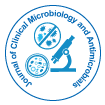
Journal of Clinical Microbiology and Antimicrobials
Open Access
+44-77-2385-9429

+44-77-2385-9429
Commentary - (2022)Volume 6, Issue 1
Amebiasis or amoebic dysentery is an intestinal infection caused by the parasitic amoeba Entamoeba histolytica. Amoebiasis can be present with no, mild, or severe symptoms. Symptoms may include lethargy, weight loss, colon ulceration, abdominal pain, diarrhea, or bloody diarrhea. Complications can include inflammation and ulceration of the colon with tissue death or perforation, which can result in peritonitis. Anemia may develop as a result of prolonged gastric bleeding.
Entamoeba cysts can survive up to a month in soil or up to 45 minutes under fingernails. Invasion of the intestinal lining results in bloody diarrhea. If the parasite enters the bloodstream, it can spread throughout the body, most commonly ending up in the liver, where it can cause amoebic liver abscesses. Abscesses of the liver can appear without previous diarrhea. Diagnosis is usually made by microscopic examination of the stool, but it can be difficult to distinguish E. hystolytica from other harmless Entamoeba species. In severe cases, an increased white blood cell count may be present. The most accurate test is the detection of specific antibodies in the blood, but it can remain positive even after treatment. Bacterial colitis can have similar symptoms.
Prevention
To prevent the spread of amebiasis in the home;
• Wash hands thoroughly with soap and hot water for at least 10 seconds after using the toilet or changing a baby's diaper and before handling food.
• Clean bathrooms and toilets often; pay special attention to toilet seats and faucets.
• Avoid sharing towels or face washes.
• To prevent infection;
• Avoid raw vegetables in endemic areas as they may have been fertilized by human feces.
• Boil water or treat with iodine tablets.
• Avoid eating street food, especially in public places where others share sauces in the same container.
To prevent E. histolytica infection at an endemic level, good hygiene practices are essential, as is responsible disposal or treatment of wastewater. E. histolytica cysts are usually resistant to chlorination, therefore sedimentation and filtration of water supplies is necessary to reduce the incidence of infection.
E. histolytica cysts can be recovered from contaminated food by methods similar to those used to recover Giardia lamblia cysts from feces. Filtration is probably the most practical method of extraction from drinking water and liquid food. E. histolytica cysts must be distinguished from cysts of other parasitic (but non-pathogenic) protozoa and from cysts of free-living protozoa, as discussed above. Recovery procedures are not very precise; cysts are easily lost or damaged beyond recognition, leading to many false negative results in recovery tests.
Symptoms
Most infected people, about 90%, are asymptomatic, but the disease has the potential to become serious. It is estimated that between 40,000 and 100,000 people worldwide die from amebiasis each year.
Infections can sometimes last for years if there is no treatment. Symptoms take anywhere from a few days to a few weeks to develop and appear, but it's usually two to four weeks. Symptoms can range from mild diarrhea to dysentery with blood associated with intense abdominal pain. Extra-intestinal complications can also occur as a result of invasive infection, which includes colitis, liver, lung or brain abscesses. The blood comes from bleeding lesions created by amoebae invading the lining of the colon. In about 10% of invasive cases, amoebae enter the bloodstream and can travel to other organs in the body. This most often means the liver, because that's where the blood from the gut reaches first, but they can end up almost anywhere in the body.
The time of onset is highly variable and the average asymptomatic infection persists for more than a year. It is thought that the absence or intensity of symptoms may vary with such factors as the strain of amoeba, the host's immune response, and possibly associated bacteria and viruses.
Citation: Vas E (2022) Prevention of Amebiasis Infection and its Symptoms. J Clin Microbiol Antimicrob. 06: 129
Received: 15-Mar-2022, Manuscript No. JCMA-22-20190; Editor assigned: 17-Mar-2022, Pre QC No. JCMA-22-20190 (PQ); Reviewed: 01-Apr-2022, QC No. JCMA-22-20190; Revised: 07-Apr-2022, Manuscript No. JCMA-22-20190 (R); Published: 15-Apr-2022 , DOI: 10.35248/JCMA. 22.6.129
Copyright: © 2022 Vas E. This is an open-access article distributed under the terms of the Creative Commons Attribution License, which permits unrestricted use, distribution, and reproduction in any medium, provided the original author and source are credited.